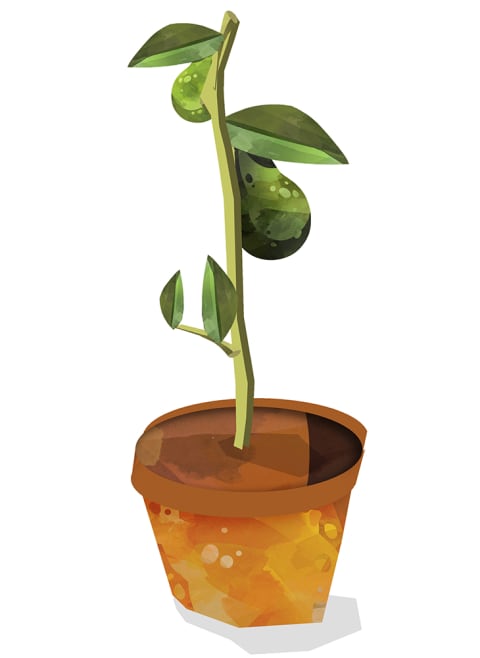Here’s everything you need to know about growing an avocado tree from seed, plus some insider tips and tricks to give yours a chance at bearing fruit. “[Begin by] gently removing the meat around the seed. Don’t try to do a deep crack with a knife. Use a fork and pop it out,” says Jessica Hunter, District 1 representative of the California Avocado Commission (yes, it’s a thing!). Hunter notes that leaving the pit’s outer skin intact will help protect it from infection. “By removing it, try not to break the skin. Make sure you give it a good wash to get all the fruit off of it,” she adds. Lastly, you need to make sure your pit is totally dry before moving on to the next step. Katja Faber, an avocado producer in Europe, tells mbg that the key to sprouting an avocado tree in water is to keep it indoors and ensure only the bottom, broader part of it is submerged in room-temperature water. You can use toothpicks for this: Stick three or four toothpicks around the equator of your seed so that it can rest on the rim of your water glass, half-submerged. Faber says that it’s imperative to make sure the water doesn’t get too dirty in that time. Replace as needed. “It starts sprouting a main root quite quickly, and then filament roots over a few weeks,” she adds. “You’ll suddenly see the plant sprout a stem, growing up, searching for light.” If you don’t see any stem peeking out the top after three months, toss your seed and start with a fresh one. If a stem does form, wait until it grows to about 6 inches in height before snipping in half and allowing it to regrow. Once it does, transfer to an 8- to 10-inch pot filled with well-draining soil, leaving the top part of the pit peeking out. Return it to its warm spot, and water as needed. You can leave it as an indoor plant or wait until spring or early summer to move it outdoors and try your luck at sticking it in the ground so it can grow big enough to eventually produce fruit. “Make sure you have at least 3 to 6 feet around the tree,” Faber suggests. Do make sure it’s protected from the wind, and give it a piece of support—Faber recommends a cane—since, at the beginning stages, its trunk is quite weak. Remember: Avocados are subtropical fruits that like the sun, hate the cold, and can’t stand the wind. Faber’s tip: Look around you and check what the vegetation is doing outside. If you’re surrounded by trees that lose their leaves in winter, an avocado tree likely is not in the cards for you. Faber tells us that avocado trees are also sensitive to water’s pH levels. The ideal range is between 5 and 7. When leaves first come out from your tree, they’ll be a deep brown okra color. Over time, they should turn green. According to Hunter, the color of your tree’s leaves tell you a lot about its health. “Pale green to dark green leaves are the best—a sign of proper photosynthesis, sunlight, and nutrition. The healthier the tree is, the stronger, more producing, and viable the tree is,” she says. The tree’s leaves can also provide clues about how you’re doing with watering: They will wilt or turn yellow when they’ve accumulated too much water. This is a sign that the root system is not breathing, Hunter explains. When they’re not getting enough water, their tips will brown at the edges and start to get brittle. Hunter says the best way to strengthen your tree and protect it from sunburn is to make sure its soil has enough nitrogen. To do so, you will likely need to apply some fertilizer. “One of the best fertilizer growers use is called 15-15-15, which contains 15% nitrogen, 15% phosphorus, and 15% potassium,” Hunter says. “It’s like a multivitamin!” This well-rounded fertilizer helps generate leaf growth and build a thicker canopy, which acts as a natural defense against the sun. “The roots on an avocado [tree] normally flush in the spring and the fall, so you want to fertilize in March or April and in September or October,” she adds. It turns out, the avocados you find in the store don’t come from trees that start from seed. “The nurseries find root stalks that come from a ‘wild tree,’ a tree that is strong and will grow for a long time and can withstand inclement weather, pests, etc.,” Faber explains. “They grow this tree until it’s hip height. Then, the type of avocado they want is grafted onto that tree.” Ultimately, when you grow a tree from a pit at home, it will be a much weaker version of the tree that the fruit originally came from—making its likelihood of producing fruit pretty low, around 20%. If your avocado tree does begin to bear fruit, its first couple of avocados should show up in its third year. It’s not until the fourth year that you will see enough fruit on the tree to really get cooking with. If you have the space, time, and certification for a commercial harvest, expect to wait until the fifth year to get that started. She notes that this waiting pattern is unique to California: Other places in the world may only have a harvest range of two to three months when the fruit is ready on the tree. This affects how the avocado tastes, as well as how long it stays ripe. Experts say you have about a 20% chance that your avocado seed will produce avocados. To ensure that your tree can grow fruit 100% of the time, you’ll need to get it from a local or commercial nursery. When you are ready to eat, make sure you scrape the entire skin of the avocado—those dark edges are the most nutritious part! When Carly’s not covering sustainability topics, she spends her time tackling social impact issues regarding the environment & its inhabitants, practicing self-reflection (on and off the mat), and reading memoirs from Black authors. She lives in Brooklyn, New York.






